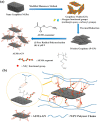Recent Advances in Polymer Nanocomposites for Electromagnetic Interference Shielding: A Review
- PMID: 35936479
- PMCID: PMC9352219
- DOI: 10.1021/acsomega.2c02504
Recent Advances in Polymer Nanocomposites for Electromagnetic Interference Shielding: A Review
Abstract
The mushrooming utilization of electronic devices in the current era produces electromagnetic interference (EMI) capable of disabling commercial and military electronic appliances on a level like never before. Due to this, the development of advanced materials for effectively shielding electromagnetic radiation has now become a pressing priority for the scientific world. This paper reviews the current research status of polymer nanocomposite-based EMI shielding materials, with a special focus on those with hybrid fillers and MXenes. A discussion on the theory of EMI shielding followed by a brief account of the most popular synthesis methods of EMI shielding polymer nanocomposites is included in this review. Emphasis is given to unravelling the connection between microstructures of the composites, their physical properties, filler type, and EMI shielding efficiency (EMI SE). Along with EMI shielding efficiency and conductivity, mechanical properties reported for EMI shielding polymer nanocomposites are also reviewed. An elaborate discussion on the gap areas in various fields where EMI shielding materials have potential applications is reported, and future directions of research are proposed to overcome the existing technological obstacles.
© 2022 The Authors. Published by American Chemical Society.
Conflict of interest statement
The authors declare no competing financial interest.
Figures


















References
-
- Wang L.-L.; Tay B.-K.; See K.-Y.; Sun Z.; Tan L.-K.; Lua D. Electromagnetic Interference Shielding Effectiveness of Carbon-Based Materials Prepared by Screen Printing. Carbon 2009, 47 (8), 1905–1910. 10.1016/j.carbon.2009.03.033. - DOI
-
- Mathur P.; Raman S. Electromagnetic Interference (EMI): Measurement and Reduction Techniques. J. Electron. Mater. 2020, 49 (5), 2975–2998. 10.1007/s11664-020-07979-1. - DOI
-
- Thomassin J.-M.; Jérôme C.; Pardoen T.; Bailly C.; Huynen I.; Detrembleur C. Polymer/Carbon Based Composites as Electromagnetic Interference (EMI) Shielding Materials. Mater. Sci. Eng. R Rep. 2013, 74 (7), 211–232. 10.1016/j.mser.2013.06.001. - DOI
-
- Zhang W.; Wei L.; Ma Z.; Fan Q.; Ma J. Advances in Waterborne Polymer/Carbon Material Composites for Electromagnetic Interference Shielding. Carbon 2021, 177, 412–426. 10.1016/j.carbon.2021.02.093. - DOI
-
- Bhat B. R.; Sahu R. P. Radiation shielding of electronic components in INSAT-2. J. Spacecraft Technol. 1993, 36 (3), 36–47.
Publication types
LinkOut - more resources
Full Text Sources
Miscellaneous

